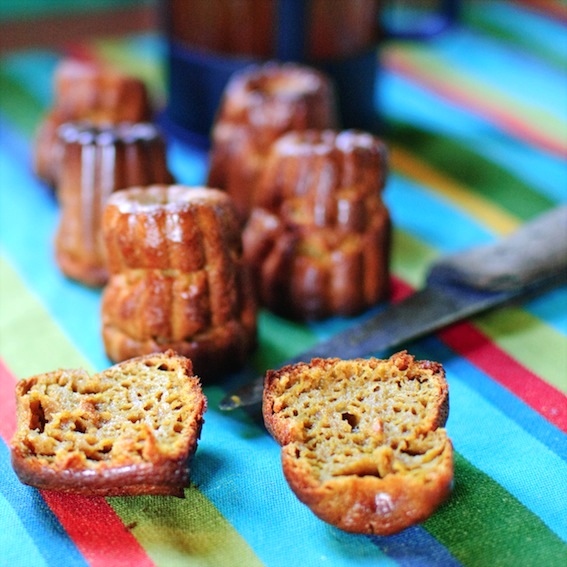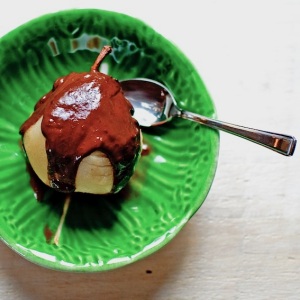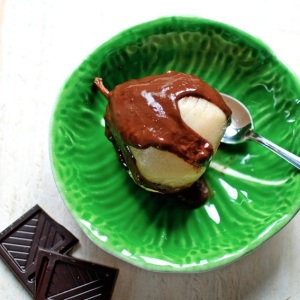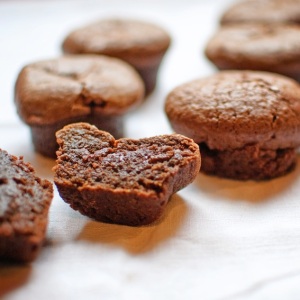-
Mini salmon terrines and getaway strategies
It’s starting to be tricky to escape in the car alone; Motoring is Hugo’s absolute favourite. He prefers the front seat and I have, in the past, resorted to belting him in rather than take on the chore of coaxing him out of the car. Naturally, he takes it very badly if I kick him out. If, on the other hand, I leave him in the car and need to stop off somewhere, he presses on the horn with his chest if he feels I’ve ‘abandoned’ him for too long. He also dribbles on the seat. So it’s a toss-up between his being put-out and potentially depressed at being ditched, and my being mortally embarrassed by a high-maintenance, disruptive dog and wet front seat. I’m spoilt for choice.
This salmon terrine is an attempt to recreate a dish we had in our hotel in the Pyrenees this winter, as requested by Léo. It is, according to him, ‘quite edible’; Praise indeed. 🙂
Ingredients (makes 6 mini terrines)
2 salmon filets (250g)
juice of half a lemon
25g butter
150ml cream
1 clove garlic, crushed
1 shallot, chopped
½ teaspoon ginger, freshly grated
1 bay leaf
1 tablespoon Pastis
sea salt and freshly ground black pepper
1 teaspoon paprika
4 tablespoons of diced cucumber
4 leaves of fresh mint
2g Agar-Agar powder
Place the salmon filets steeped in lemon juice in a frying pan and add the butter and cream. Bring to a gentle simmer and add all the other ingredients with the exception of the Agar-Agar, cucumber and mint leaves. Simmer for about 10 minutes, until the salmon is cooked through and the liquid partly evaporated. Once cooked, add the mint leaves, blend briefly in a food processor and set aside. Dissolve the Agar-Agar in a small amount of water and bring to the boil (according to the instructions on the packet). Once boiled, mix into the salmon with the diced cucumber and distribute the mixture into moulds (I used silicon muffin moulds). Compact the mixture well. Refrigerate for at least a couple of hours and serve chilled.
-
Canelés de Bordeaux

There is an exquisite patisserie called Pariès in Bayonne, which is the capital of the Basque country in south-western France. They recently produced a book of their recipes, which Idrooled overdiscovered the other day. Bayonne is famous for its chocolate, amongst other things, and was one of the first places in Europe to produce chocolate in the early 17th century. There is always a deliciously rich, chocolate-laden aroma in the streets of the city centre. It’s sometimes worth just strolling around there to get a fix!
I will be sharing some of the chocolate recipes from this absolute gem of a book, but today I made another regional speciality: canelé [kan-ul-ay]. A canelé (or cannelé) is a small French pastry with a moist custard-like centre and a dark, thick caramelized crust. It is the shape of a striated cylinder approximately 5 cms in height and is a specialty of Bordeaux.
These contain too much sugar for me to claim that they’re positively good for you. Having said that, I made them with cane sugar and spelt flour (of course!) and as they contain rich, ‘real’ ingredients they are most definitely a healthier choice as a treat than anything in packaging! I had to make a second batch to photograph because the first batch disappeared far too quickly; They’re that moreish!
Ingredients (makes about 12)
You will need a special canelé mould to make these. The best are made from copper, although I used silicon.
400ml milk
20g salted butter
2 egg yolks
1 egg
140g sugar (I used cane sugar)
120g flour (I used spelt flour)
1 vanilla pod
10cl rum
A little extra butter for greasing the moulds
Beat the egg yolks, egg and sugar in a mixing bowl. Add the flour and vanilla and continue to mix gently. Bring the milk to the boil in a saucepan, remove from the heat and immediately add the butter. When the milk has cooled to lukewarm, add to the other ingredients in the mixing bowl. Mix well. Leave the mixture to rest in the fridge for at least 24 hours, 48 hours if possible. This is important as the mixture must be as ‘airless’ as possible or it will rise during cooking. Also for this reason, it must always be mixed gently, taking care not to add too much air.
To cook the canelés, preheat the oven to 220°C. Remove the mixture from the fridge and very gently stir the (what will now be separated) batter until homogenous. Add the rum at this stage too. Fill the buttered moulds about 7/8 full. Cook for 10 minutes at 220°C and then turn the oven down to 190°C. Cook for a further 40 minutes. Leave to cool before eating. -
Olive, red pepper and anchovy cake and a volatile hoarder
To follow on from this post, unfortunately our black hen died. Hens seem to be so vulnerable to attack from disease, foxes, dogs and perhaps even other hens. I imagined she was suffering from depression when maybe she was just sad to be sick. 🙁
We were (when I say ‘we’ I suppose I mean ‘I’ as, unlike me, neither husband nor son obsesses about our animals) rather worried about the white hen who had disappeared suddenly. We eventually found her over a week later under two enormous bales of hay in a little-used barn, sitting on no fewer than 23 eggs; The little minx had obviously been hiding, laying and hoarding! Don’t ever let it be said that hens can’t multitask. So to add to our animals’ extensive list of mental disorders, we now appear to be the proud owners of a compulsively hoarding hen. Can anyone tell me where I can get my hands on an animal that doesn’t have ‘issues’?
This savoury cake is based on an old French recipe and goes beautifully with soup or hors d’oeuvres. It’s quite light and crumbly and, being made with spelt flour, healthy, wheat-free and low GI.
Ingredients
175g spelt flour
1 teaspoon baking powder
1 teaspoon bicarbonate of soda
1 teaspoon paprika
1 pot of yoghurt (125g)
3 organic eggs, beaten
100ml olive oil
50g red pepper, finely chopped
40g black olives, stones removed
50g sun dried tomatoes
6 anchovies
Preheat the oven to 180°C. Combine the flour, baking powder, bicarbonate of soda and paprika and add the eggs and yoghurt, mixing well. Continue mixing and add the olive oil until you obtain a homogenous paste. Stir in the other ingredients and once well combined, spoon the mixture into a medium-sized, oiled loaf tin. Cook for about 40 minutes, or until a fork comes out clean.
-
Spelt flour crêpes and the chaos theory according to Hugo
by Hugo, Canine CorrespondentIn the interests of transparency (have you noticed the trendy lingo I’m picking up?), I asked to write today’s blog because I don’t think that the Bossy One is always very honest with you.
The way she presents her recipes would have you believe that she’s a domestic goddess (I heard that on the television), when in fact, nothing could be further from the truth. The havoc she creates in the kitchen is quite something. Not that I’m not complaining because the more the food ends up on the floor, the happier I am. 🙂
Today’s recipe, for example, should really read something like this:
Sift the flour, salt and bicarbonate of soda into a mixing bowl, use a large shovel to scoop up the ingredients that somehow landed outside the bowl, whilst simultaneously trying to recover from violent coughing and sneezing fit caused by inhaled flour. Make a well in the centre and break the eggs into it, mutter obscenities and pick the broken bits of eggshell out with your fingernails. Whisk the eggs, little by little incorporating the surrounding flour. If you use an electric whisk, you can be sure that a substantial amount of mixture will end up on the surrounding walls, sometimes even the ceiling. Combine the almond milk and water and add little by little to the flour/egg mixture. Turn the whisk to SLOW before pouring in liquid, otherwise it will ricochet alarmingly which isn’t good because it causes more mad muttering (I can also do alliteration :-)). Once all the liquid has been added, continue to whisk until you obtain a smooth batter, the consistency of thin cream (yeah right; in her dreams!). Push back messy hair, smothering small amount of ‘smooth’ ( 😆 ) batter over face.
I won’t go on because she can be a bit sensitive when it comes to criticism, even if it is constructive, and I’d like to continue this writing lark. I will leave you with this thought though: this is a simple recipe – just imagine the scenario with a complicated one 😉

Thank you for your kind words Hugo, I think I’ll take over now. This is based on Delia Smith’s recipe for ‘basic pancakes’, which I have adapted to use with spelt flour and almond milk.
Ingredients (makes about 10 crêpes)
110g spelt flour
pinch of salt
pinch of bicarbonate of soda
2 large eggs
200ml almond milk
75ml water
butter or coconut oil for cooking
Sift the flour, salt and bicarbonate of soda into a mixing bowl, make a well in the centre and break the eggs into it. Whisk the eggs, little by little incorporating the surrounding flour. Combine the almond milk and water and add little by little to the flour/egg mixture. Once all the liquid has been added, continue to whisk until you obtain a smooth batter, the consistency of thin cream.
To cook the crêpes you will need a shallow frying, or preferably a crêpe pan. Melt the butter or coconut oil making sure that the base of the frying pan is coated. Pour a small amount of batter into hot fat in the pan, tipping from side to side to distribute evenly. Cook until golden brown on both sides.

-
‘Barigoule’ baby artichokes and rubber bands for life

Last week a courier service mistakenly delivered an envelope containing 1,580 rubber bands to our house. They were in fact destined for the UK, so they hadn’t even got the right country, which is really no recommendation when you’re an international courier service. Bearing in mind that we live well off the beaten track, about six kilometres from the nearest village, I had the following conversation with the misguided driver this morning:
Driver : ‘Hello we were wondering whether you still had the envelope containing 1,580 rubber bands delivered to you last week by mistake?’
Me : ‘Yes. I kept the envelope – I was going to add them to my collection.’
Driver : ‘I have to come and pick the package up this afternoon and wondered whether you could bring it to the nearest village?’
Me : ‘Sure, I’ll make a 12km round trip to save you the trouble. Shall we fix a time now or later for you to come to me and muck out the horses and vacuum the house?’
In the end, he did reluctantly concede that it was probably part of his job description to drive out to us to pick up the envelope and anyway, he would definitely rather do that than muck out my horses. I don’t think he ‘got’ the irony though and probably just thinks that I’m a batty, lazy, rubberband-hoarding hermit! Not that it really matters what he thinks because this conversation was six hours ago and he still hasn’t managed to find us :lol:.
Artichokes are an excellent source of fibre and also contain plenty of folic acid and vitamins C, K and B complex. They are also a rich source of antioxidants and minerals such as copper, calcium, potassium, iron, manganese and phosphorus.
This makes a delicious starter or even on its own as a light meal.
Ingredients (serves 4)
4 tablespoons of olive oil
2 medium sized onions, sliced
4 cloves of garlic, peeled and crushed
8 baby artichokes, stems and outer leaves removed and chopped lengthways
4 rashers of smoked bacon, sliced
1 bay leaf
150ml white wine
water to cover vegetables
sea salt and freshly ground black pepper
1 teaspoon piment d’Espelette (or paprika)
Brown the onions and garlic in a casserole dish (Dutch oven) in the olive oil. Add the artichokes, being sure to turn and coat them well with olive oil, and the bacon and continue frying for a few minutes. Add the wine and seasoning , cover and continue to simmer for about 45 minutes. There should be just enough liquid to cover the artichokes so you will probably need to add some water. Towards the end of cooking, remove the lid and reduce the liquid by about half. -
Alcoholic pears and chocolate sauce

Did you know that alchohol doesn’t completely evaporate when you use it for poaching? No? Neither did I. I poached some pears in calvados yesterday morning to make this and, once they were cooked, I was tempted, Alice in Wonderland-style, by the delicious-looking poaching juice that had ‘drink me’ written all over it. Big mistake. I’ll leave to your imagination the damage done by a hefty measure of calvados on the empty stomach of someone who gets tipsy on anything more than a glass of wine (in the evening, with food). Just how ‘blonde’ can you get? Yesterday wasn’t a productive day, but it was a happy one!
I suppose that pear alcohol, such as Poire Williams, would work well too. If you try it, please let me know because I’m certainly not taking the risk 😉
Ingredients (serves 4)
4 pears, peeled carefully
25ml calvados
1 teaspoon cinnamon
50g of dark chocolate (min. 70% cocoa solids), in small pieces
120ml green tea
Place the pears in a casserole and fill with just enough water to cover them. Add the calvados and cinnamon and gently simmer for 20 minutes. They are cooked when you can stick a knife in with no resistance. Harder varieties, such as Conference will need to be poached longer than say, Williams. Drain well, taking care not to damage them.
Bring 120ml of green tea to the boil in a small casserole. Then add the chocolate pieces and stir well until the chocolate has all melted and you have a homogenous consistency. Serve the pears with the chocolate sauce poured over the top.

This dessert has been suggested for While Chasing Kids’ ‘skinny parade’. -
Leek and Bayonne ham quiche (gluten free)

If the 1980s bestseller ‘Real Men don’t Eat Quiche’ is anything to go by, you might want to refer to this as egg, leek and ham pie if you feel that might go down better with the men at your table. Of course, strictly speaking, I suppose it’s a tart and not a pie, but I’d put money on the fact that a man who won’t eat quiche won’t be buying into ‘tart’ either. Anyway, enough wittering, I believe in calling a quiche a quiche and if the neanderthals eating at my table don’t like it they can go and shoot their own dinner 😉 My alpha-male husband is actually the exception that confirms the rule – he worships at the altar of The Quiche.
The pastry is made with buckwheat flour, which not only makes it gluten-free, but healthier and tastier than regular pastry; it even stays crisp when served cold. And even if you don’t fancy quiche, it makes a superb base for apple, or any other fruit tart too.
Ingredients for pastry (serves 6-8):
220g buckwheat flour
80g butter
20g virgin coconut oil
Roughly 5 tablespoons of cold water
Ingredients for filling:
3 leeks, washed and chopped
2 shallots, sliced
1 tablespoon of olive oil
75ml chicken or vegetable stock
Sea salt and freshly ground black pepper
1/2 teaspoon paprika
1 egg
150 ml double cream
2 thin slices of Bayonne ham (or Parma ham), cut into strips
50 mg Cheddar, Parmesan or Comté cheese, grated
To make the pastry, begin by cutting the butter and coconut oil into small cubes. Add to the flour in a mixing bowl and add a pinch of sea salt. Blend by hand until the mixture becomes crumbly. Add the cold water, mixing rapidly with a spoon. Remove the mixture from the bowl onto a lightly floured surface. Knead until you obtain a ball of pastry (if the mixture isn’t ‘sticky’ enough to form a ball, you may need a drop more water). Wrap in a clean cotton tea towel and leave to ‘rest’ in the fridge for about two hours. This relaxes the dough and makes it easier to use.
Preheat the oven to 180°C. Roll out the pastry on a clean, lightly floured surface and fill the tart tin or tins. Buckwheat pastry contains no gluten, which makes it very fragile. You’ll find that you have to treat it delicately and possibly fill in the cracks with remaining bits of pastry by pressing gently. I tend to use individual tart tins. Precook the pastry for 12 minutes.
For the filling, begin by frying the leeks and shallots in olive oil in a small frying pan. Add the stock and braise for about 20 minutes, or until the leeks are well-cooked and the stock is absorbed. Break the egg into a small bowl and add the cream and seasoning (salt, pepper, paprika). Beat well to form a homogenous mixture. Place a few small strips of ham on the pastry base, spoon the leek mixture over that, add some grated cheese and then pour the egg and cream mixture over the top. Cook at 180°C for 20 minutes, or until the top is golden-brown in colour.

-
Toulouse sausages with Puy lentils and exiled hens

Our hens are in exile; they have been forced from their homeland by an overabundance of horses. Four was fine, desirable even; it created a cosy ‘chicken sandwich’ environment. But the newly-arrived pony was the final straw – she’s a Quadruped Lout Too Far and a tiny bit scornful perhaps at the deference required to lay an egg.
So they’ve set up camp on the fourth-floor shelf of the workshop on some torn-up sheets. Not without much shrill, dyspeptic screeching, I might add. I feel a bit bad that all they found for their nest was old sheets and not pashminas, but such is the life of a hen. I only discovered their new hideout because, reaching for an old sheet to clean my saddle, I unwittingly scrambled an egg at my feet. I assume they think that the workshop is horseproof – I’m afraid they’re in for a surprise 😉
Puy Green Lentils (grown on the vocanic soil of the ‘Massif Central’) are prized above other lentils for their strong peppery flavor and firmness, even after cooking. High in fiber and protein, they also contain dietary fibre, folate, vitamin B1, and minerals. As if all that isn’t enough, they also have a very low GI (glycemic index).
Ingredients (serves four)
4 Toulouse sausages
1 tablespoon olive oil
1 small red onion, peeled and chopped
3 cloves of garlic, peeled and finely chopped
5 mushrooms, peeled and sliced
3 medium sized carrots, peeled and cut into 3cm pieces
1 tin (400g) of plum tomatoes
200g of Puy lentils
2 sprigs of rosemary
1 bay leaf
250ml chicken stock
seasoning to taste: sea salt, fresh black pepper, paprika
Preheat the oven to 150°C. If you have a griddle pan, griddle the sausages briefly. If not, searing them will do just as well. Gently fry the onions, garlic and mushrooms in olive oil to soften them. Add the griddled/seared sausage, the plum tomatoes and carrots and continue to heat. Add the lentils, chicken stock, herbs and seasoning and bring back to a gentle simmer. Cook in the oven for about 45 minutes, checking from time to time that there is enough liquid – the lentils absorb an enormous amount.

-
Duck confit and underachievers

I sometimes suspect I might be a bit of a slacker. I’m always hearing about people ‘power walking’, whereas I walk, or at a push, hike if hiking’s called for. And do I spend ‘quality time’ with my family? We eat lunch and dinner together and sometimes even load/unload the dishwasher (although this does inevitably involve heated discussion), but is this enough to qualify? ‘Foodies’ is a term also frequently used. I enjoy cooking andam a bit greedyhave a good appetite, but does this make me a foodie? I could go on, but will stop before I completely trash myself 😉
If I were a ‘power-walking’ sort of person, I would no doubt confit my own duck. As it is, I buy it in a tin. Quite apart from my ‘underachieving’ status, there’s absolutely no way I could confit a duck that I had built up a relationship with (ie caught a glimpse of whilst still alive).
Duck confit (or ‘confit de canard’) is a speciality of Gascony. Confit is a process of preservation that consists of salt curing a piece of meat (generally goose, duck, or pork) and then poaching it in its own fat. Duck fat is a healthy choice for cooking – it contains 35.7% saturates, 50.5% monounsaturates (high in linoleic acid) and 13.7% polyunsaturated fats (which contain omega-6 and omega-3 oils).
Ingredients (serves four)
4 confit duck thighs (either from a tin or preserved in a jar)
Turn the thighs and solidified fat out into a deep frying pan. Heat on a very low heat to liquefy the fat very gradually. Little by little, drain the liquefied fat from the frying pan into another container and set aside to use as cooking oil for potatoes. Once the surplus fat is drained off, turn the heat up to medium and cook for about eight minutes on each side. The result should be dark golden-brown and very very crisp.
May be served alone with green beans or salad with walnut oil dressing, or with cubed potatoes fried for 15 minutes in the duck fat and garnished with crushed garlic.
And finally, once again for those worried about consuming dishes so apparently high in dietary fat:
‘A high cholesterol diet is not the cause of atherosclerosis. In 50 men with a fourfold increase in dietary cholesterol, two-thirds failed to show an increase in serum cholesterol. Seven patients in another study, while consuming large amounts of beef fat and vitamin and mineral supplements, showed a decrease in average cholesterol levels.’ Roy W. Dowdell, MD, Health Freedom News -
Mini chocolate hazlenut cakes (gluten-free)

I’m stunned: I just read a newspaper article about losing weight that actually made good sense. It advocates walking/skipping/moving yourself in whatever way you fancy over going to the gym. It favours eating full-fat dairy products in moderate quantities over highly processed food and lastly it advises turning your central heating down or off. It’s all based on the principle of turning white fat (lazy fat) into brown fat (active fat). I can’t see it catching on though — ‘Common Sense and Beige Fat’ is hardly bestseller title material is it?
Here are some delicious mini chocolate cakes, to be consumed with moderation after a brisk walk in the fresh air and the central heating down low.
Ingredients (makes 16)
200g dark chocolate (minimum 70% cocoa solids)
150g butter
130g cane sugar
4 eggs, beaten
60g powdered hazelnuts
60g powdered almonds
Pinch of salt
Preheat the oven to 180°C. Melt the chocolate and butter together. Combine the beaten eggs and sugar, gradually adding the powdered almonds and hazelnuts. Add the melted butter and chocolate mixture to the egg mixture and combine well. Pour the mixture into mini cake moulds and bake for 20 minutes.



